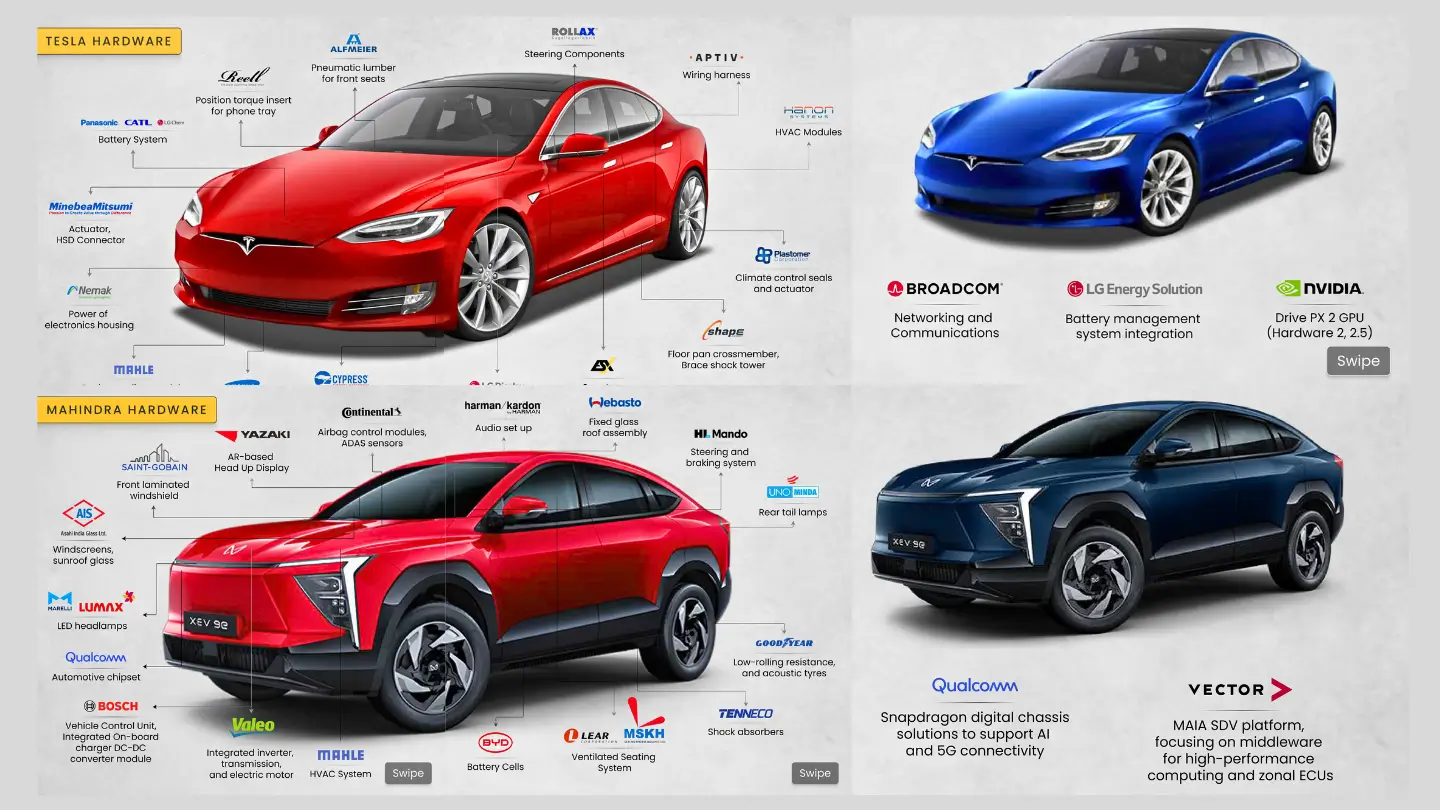
As the global automotive landscape accelerates toward electric and autonomous mobility, two automakers—Mahindra and Tesla —illustrate contrasting yet innovative paths to the software-defined vehicle (SDV).
While Tesla is known for its end-to-end vertical integration and advanced autonomous systems, Mahindra is building scalable, modular platforms supported by AI and cloud connectivity.
This article examines the key hardware and software components of Mahindra vs Tesla’s EVs and provides a clear outlook on the future of EV architecture.
Tesla’s hardware reflects its philosophy of complete system control.
From the FSD (Full-Self Driving) Processor to integrated electric motors, battery packs, and windscreen technologies, Tesla engineers every part of the vehicle to serve the broader mission of autonomy and energy efficiency.
Key highlights include:
FSD Processor: A proprietary chip designed for Tesla’s Autopilot and Full-Self Driving capabilities.
Drive PX 2 GPU: NVIDIA’s AI platform embedded in Tesla’s Hardware 2 and 2.5 generation for neural network inference.
Norflash Memory & Electronics Housing: Enables fast data logging and real-time computing for edge processing within the car.
Integrated Inverter, Transmission, and Motor: Reduces power loss and increases overall drivetrain efficiency.
Advanced Climate and Structural Components: Includes position torque inserts, shock tower braces, and actuator-driven HVAC systems.
Tesla’s software suite is equally robust, emphasizing full control from operating systems to real-time autonomous decision-making. The stack includes:
Vehicle Controls and UI: Custom-built OS and user interface systems unique to Tesla’s vehicle models.
Battery Management Integration: Closely linked with software for range optimization, cell balancing, and predictive diagnostics.
Networking and Communication Modules: For V2X (vehicle-to-everything) protocols and OTA (Over-the-Air) firmware updates.
Autonomous Features: Powered by neural networks and real-time sensor fusion for Autopilot and FSD.
Mahindra’s approach to EV hardware is pragmatic, emphasizing passenger comfort, durability, and scalable design.
Rather than reinventing components in-house, Mahindra collaborates with leading suppliers and focuses on efficient integration.
Hardware features include:
Battery Cells and Shock Absorbers: Fundamental elements for power delivery and ride comfort.
Ventilated Seating and Acoustic Tyres: Designed for quiet, climate-controlled interiors suited for Indian and global climates.
Steering and Braking Systems: Conventional yet reliable mechanical systems.
Fixed Glass Roof and Rear Tail Lamps: Enhancing aesthetics and structural integrity.
Mahindra is betting on MAIA, its SDV platform, to build future-ready vehicles.
Unlike Tesla’s in-house OS, Mahindra partners with key chipmakers and software vendors for flexibility and rapid feature rollouts.
Software innovations include:
The EyeQ6 System-on-Chip (SoC), provided by Mobileye, supports Level 2 ADAS (Advanced Driver Assistance Systems) with visual and radar fusion capabilities.
Snapdragon Digital Chassis: Qualcomm’s automotive-grade SoC for AI, 5G, and edge applications.
OTA Updates: Enables Mahindra to deliver new features, fix bugs, and enhance vehicle performance over time.
Zonal ECUs with High-Performance Computing: Reduce wiring complexity and support modular vehicle development.
| Feature | Tesla | Mahindra |
|---|---|---|
| Core Focus | Full-system autonomy | Scalable software integration |
| Autonomy | FSD with in-house chip | EyeQ6 for Level-2 ADAS |
| Infotainment | Tesla OS + custom UI | Snapdragon-based dashboard |
| Updates | OTA since 2012 | Recent OTA integration |
| Battery | System-level integration | Modular cell-level components |
| Drive System | Integrated motor-inverter-transmission | Modular mechanical drivetrain |
| Platform | Custom Tesla architecture | MAIA SDV platform with zonal ECUs |
Tesla continues to push the limits of automotive AI and autonomy with a proprietary approach.
Mahindra, meanwhile, is rapidly evolving into a connected mobility player, combining best-in-class chips, scalable platforms, and comfort-centric designs to meet a broader market.
Both strategies showcase the diversity of paths leading to next-gen EVs—Tesla through tight integration and in-house innovation, and Mahindra through agility, modularity, and strategic partnerships.
Disclaimer:
The technical information and component details referenced in this article have been sourced from a presentation PDF shared by EVINDIA. You can view the LinkedIn post here. Full Image credit goes to EVINDIA for compiling the hardware and software data on Tesla and Mahindra electric vehicle platforms.
This post was last modified on June 27, 2025 7:46 pm
In a major stride toward sustainable mobility, the Himachal Pradesh Police have incorporated six custom-modified Tata Curvv electric vehicles into…
In India, the automotive and transport industry is undergoing significant changes. This transformation isn't just about improving roads and infrastructure;…
Montra Electric, the clean mobility brand from the prestigious Murugappa Group, has launched the All-New Super Auto, a next-generation electric…
Union Minister Nitin Gadkari (Minister of Road Transport and Highways of India) has once again made a bold statement that’s got…
India’s electric four-wheeler (E4W) market slowed in September 2025, following a record-breaking August, with 15,038 units sold, representing an 18%…
India’s EV market hit 1,04,056 electric two-wheeler sales in September 2025. TVS, Bajaj, and Ather led the chart, while Ola…
This website uses cookies.